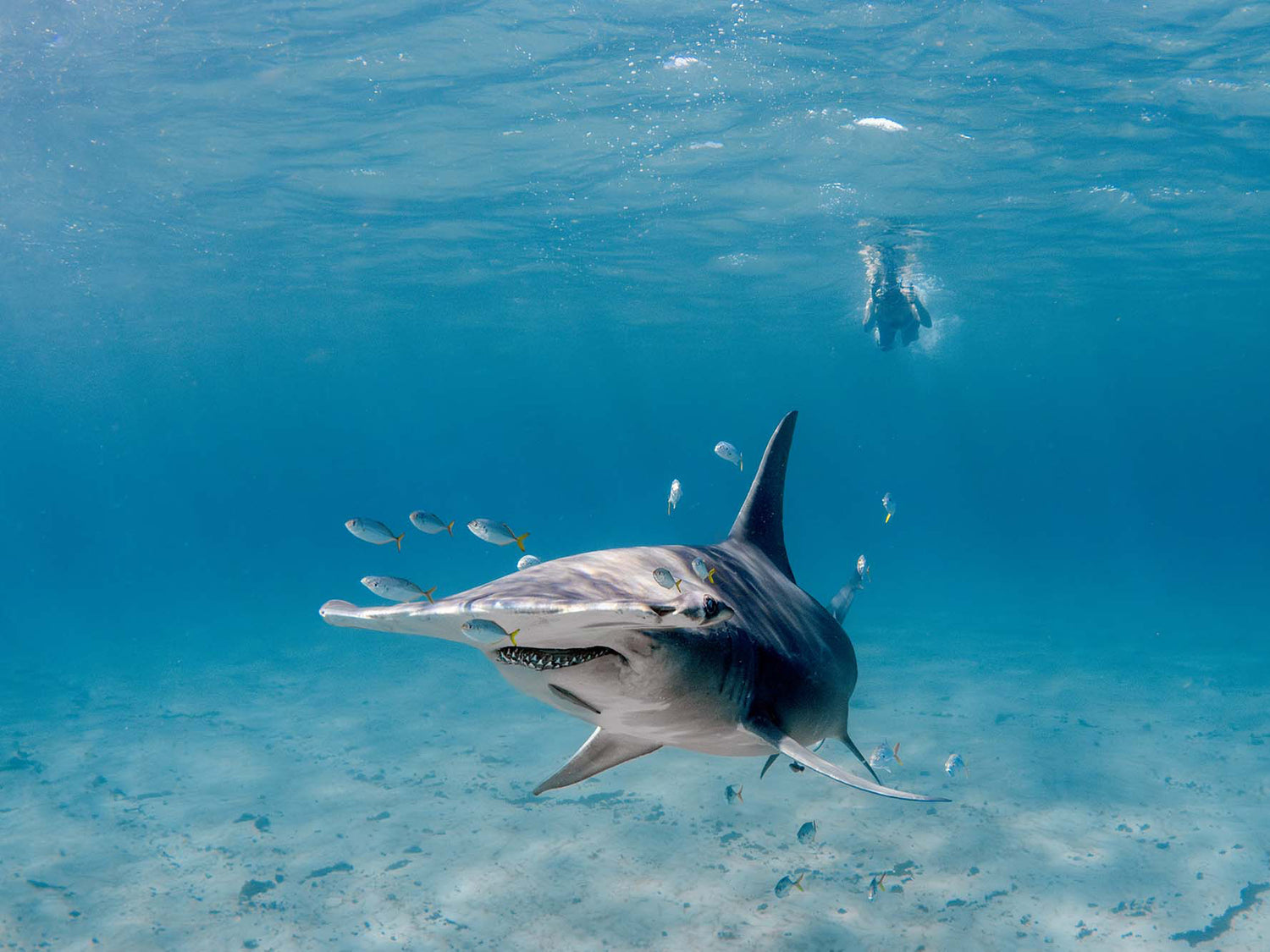By Bryant Turffs
As a long time Canon SLR shooter, I recently took the plunge into mirrorless with the Canon R10. I was excited for this opportunity, because on paper, the new generation of mirrorless cameras, including the R10, should vastly outperform my old DSLR’s. That said, I had heard about some potential drawbacks to mirrorless for underwater use, and I was curious to see how I would feel about shooting mirrorless first hand.
Ever since receiving a Canon Rebel camera as gift, more than a decade ago, I have been a Canon APS-C shooter. I have had several Rebel’s and 7D cameras over the years and have enjoyed their reliability and performance. My primary underwater cameras have been a Canon Rebel SL1 in a 200DLM housing and a Canon 7Dmkii in a 200DL housing. I preferentially shoot the 7Dmkii for the improved autofocus performance, shooting speed, and options provided by the 200DL housing. I still own and use both of these reliable systems. Previous investment is one reason I have stuck with these cameras, and the crop sensor Canon APS-C systems in general, and I was curious if the Canon R10 could convince me to jump ship to mirrorless altogether.
Spoiler Alert! After a couple months shooting the R10, I am convinced that mirrorless is not only the future, but a better present too. I hope that you find my insights helpful in deciding what system to purchase whether you are making a first time investment, or upgrading from a DSLR like me.

Sea Nettle - Canon R10 with Tokina 10-17mm Fisheye © Bryant Turffs
Initial Impressions of the Canon R10 and Ikelite 200DLM Housing
On removing the R10 from the box, my initial impression was one of familiarity. The ergonomics of the R10 are generally similar to my past Canon cameras. The feel of the R10 body has more in common with the Rebel SL line, than the larger and heavier 7d series. It is very lightweight and quite compact. The menu systems are familiar and easy to navigate for a previous Canon user, but are greatly expanded with many new options unique to the mirrorless world; notably, many more autofocus options.

7Dmkii Housing Left and R10 Housing Right
One welcomed and notable ergonomic change, compared to my Rebel, is the dedicated aperture thumb dial. One less welcomed change for me is the ISO button, which moved from the top of the camera to the back. Of course, the R10 offers many user customizable buttons, so I had the option to move the ISO function to the top of the camera, similar to where it would be on a DSLR. I chose, however, to get used to it and use these customizable buttons for other functions… more on this later.

7Dmkii Housing Left and R10 Housing Right
The 200DLM housing was also familiar for a long time Ikelite user. This is the smaller of the two base housings manufactured by Ikelite, and is very similar to the Rebel SL series housing. It is lightweight but strong and imbues me with the confidence to bring my camera underwater. I was very pleased to have the DLM housing in my hands again, as it is lighter, smaller, and more streamlined than the DL housing used by my Canon 7Dmkii. Nothing against the DL housing, but in my opinion, a smaller lighter housing will always be a welcome convenience.

R10 vs 7Dmkii housing in my carryon travel suitcase
The Electronic Viewfinder (EVF)
The main difference between my Canon DSLR cameras and the newer mirrorless camera is of course the electronic viewfinder (EVF). I have heard others complain of lag, black out, lack of resolution, and general difficulty adapting to EVFs. I had also heard that in scenes requiring high dynamic range (those with very bright and dark areas in the same frame, e.g. a reef scene with shadows and sunburst), the EVF might not adequately represent the scene compared to an optical one, making framing difficult. My initial impression on looking through the R10’s viewfinder for the first time however, was that it was a non-event… in a good way! I hardly noticed the difference to be honest. Perhaps, I am not as sensitive as some, but the viewfinder was bright and clear, it represented the scene well and allowed me to frame my images without stress.
In time, I grew to prefer the EVF over my old optical ones. In particular, I loved the ability to use the viewfinder to represent exposure before shooting. This is referred to as exposure simulation and unlike with the optical viewfinder, it shows your exposure in real time before you shoot. This was especially useful when shooting ambient light images in manual exposure mode, where I found myself making fewer mistakes and retaining more keepers.
There are times however, where exposure simulation mode is not ideal. One example might be shooting a dark scene that you intend to light with strobes, which would appear black in the EVF until the strobes fire. For these moments the R10 is equipped with an optical viewfinder simulation mode that will brighten up the viewfinder and mimic how the scene would appear through a DLSR. I found this very useful when shooting with strobes and I programed the customizable multi-function button on top of the camera to allow me to switch between these two viewfinder modes with one button!
All in all, the EVF is a win in my book. One additional viewfinder advantage that I found in the R10 camera is the back screen. My DLSR’s featured a large back screen that could be used to frame images too. I rarely used it on my 7Dmkii though, because it compromised autofocus performance. For the mirrorless camera though, the autofocus performance is the same either way. When I would historically take a risk and “shoot from the hip” (not looking through the viewfinder at all), such as when free diving and shooting fast moving wide angle subjects, I can now use the back screen and take more care when framing. Yet another win for mirrorless.

Juvenile angelfish - R10 with RF85mm macro © Bryant Turffs
Autofocus
Not too long ago, it seemed that the conversation around autofocus was that mirrorless cameras, because they lacked a dedicated focus sensor, would never perform as well as a DSLR. Now that argument has flipped. Camera engineers have embraced AI subject recognition and hacked newer faster processors to improve upon and surpass DSLR autofocus capabilities.
Right away, it was clear that the R10 had an advantage. The 7Dmkii has 65 focus points, whereas the R10 focus points literally fill the screen. I typically use continuous autofocus (servo) to track subjects and account for my own movement underwater. The 7D does a decent job at locking onto something in the foreground and accounting for its movement, but I typically limit the autofocus area to prevent it focusing on non-subjects in frame. It also requires that I sometimes focus and then recompose or manually move the focus point for off center subjects. With the R10 in Subject Recognition and Tracking mode, the blue focus area box seems to immediately lock onto the subject, stick to it, and follow it around the frame. It even tracks the subject past other items in the frame with limited confusion!
One quirk I did notice with the R10 focusing system was that on the few occasions it lost focus, it took longer to regain it. To be fair, this did happen in a less-than-ideal situation in which I was trying to shot fast-moving macro subjects whilst free-diving. I certainly would not write off the R10 for this quirk and its easily possible that I have not yet optimized the system for my use. With the 7D, I have learned to finesse the focus button when I lose the subject, which allows me to refocus quickly. I tried using this technique with the R10, but could not prevent the camera from hunting though the full focal range before regaining the subject. No matter overall though, as the R10 spent much more time in focus than the 7D and produced many more keepers in these challenging conditions.

Creative Zoom Blur Lionfish - R10 with 18-45mm © Bryant Turffs
Battery Life
Battery life is one place that my old 7D has the advantage for sure. The R10 is equipped with a smaller batter than the 7D, and the EVF is an additional power draw. With the 7D I was confident that I could do 4+ dives in a day without draining the battery. The R10 actually exceeded my expectations on this front, and I am confident in getting two, probably three shooting intensive dives out of a battery. It likely will not, however, make it the whole day on a live-aboard. If swapping batteries on your surface interval is too cumbersome, you can consider the higher spec R7 which, has a larger battery. Ikelite also allows an option for in housing charging on the larger DL series housings for those who really worry about the battery!
Speed
Burst rate typically is not a big concern for the underwater photographer. In some ambient light shooting situations, however, I like to put my camera on high speed drive mode and blast away! This is useful for instance when free diving with fast moving subjects, like sharks and dolphins. In this category, the R10 wins handily with its 15 FPS using the mechanical shutter and even more with the electronic shutter. It should be noted that burst shooting underwater in lower light conditions with the Canon R10 is possible at an impressive 10fps when using professional-grade Ikelite DS Strobes.


Hammerhead approach with 7dmkii at 10fps © Bryant Turffs



Hammerhead approach with R10 at 15fps © Bryant Turffs
Video and New Mirrorless Features
As a stills shooter, I won’t comment much on the R10’s video capabilities other than to say that the specs are terrific for a camera in its price range. I did briefly shoot some video with the 18-55mm lens and found that the continuous movie autofocus performed very well. The footage came out crisp and clear, so I expect this camera will make the hybrid video / stills shooter very happy, though it does lack the in body image stabilization present in its higher spec sibling, the R7.
One other feature that I enjoyed playing with is the “pre-capture” mode. This mode starts the camera recording still images when the shutter button is depressed halfway, but does not save them until you press it fully. When the shutter is fully depressed the camera records this series of stills beginning 0.5 seconds beforehand. It promises no more despair over those moments you just missed. In theory, if you are trying to capture a difficult behavior, you can enable this mode, half depress the shutter, watch until the behavior happens and then press the shutter just afterwards. Very cool! I do see this feature having limited application underwater however, as it won’t work with strobes. That said, when shooting behavior in ambient light it could be very helpful.
The R10 and Ikelite 200DLM Kit

Demo of 18-45mm lens range. Lizardfish zoomed into 45mm. Canon R10 and 18-45mm. © Bryant Turffs

Demo of 18-45mm lens range. Lizardfish zoomed out to 18mm shot from the same perspective. Canon R10 and 18-45mm. © Bryant Turffs
The R10 is available from Ikelite as a reasonably-priced, high value package. It includes the camera and 18-45mm kit lens along with a six inch dome port. This alone gives you a powerful underwater imaging system to document your experiences and fulfill your creative desires. The images accompanying this section were taken with this set up alone. The 18-45mm lens allows you to capture reasonably wide angle scenes, portraits of fellow divers, and also smaller subjects approaching macro range. Adds on this package that I recommend are a tray for a more comfortable grip and mounting accessories, a vacuum system to detect leaks, strobes, and dedicated lenses for macro and wide angle.

Spotted Drum - Canon R10 and 18-45mm. © Bryant Turffs

Spadefish - Canon R10 and 18-45mm. © Bryant Turffs

Green moray - Canon R10 and 18-45mm. © Bryant Turffs
Lens Options Beyond the 18-45mm

Manta Silhouette - R10 and Tokina 10-17mm Fisheye
The R10 accommodates many great lens options for the underwater photographer. The new Canon mirrorless RF series includes some great choices and older EF series DSLR lenses can be adapted to it as well.
One the very wide angle side, I shoot a lot with the Tokina 10-17mm Fisheye. It is an economical lens and one that many DSLR shooters will have in their bags. Using the Canon EF to RF adapter this lens performs as well as ever, if not better! There is not yet a dedicated RF series fisheye, but the Tokina lens can be found second hand, as can the higher end Canon EF 8-15mm fisheye.
There are also some good options for shooting rectilinear wide angle lenses with the R10. These lenses, while not as wide as a fisheye, create less distortion and are therefore useful when shooting models and manmade structures, like wrecks or piers. Existing EF-S lenses like the 10-18mm and 10-22mm should adapt well, though I have not yet tried them. There are also promising new RF options like the RF-S 10-18mm which, appears to be an economical performer, and the RF 10-20mm, which has all the makings of a dream lens for me.

Mosquitofish - R10 and EF60mm Macro © Bryant Turffs
On the Macro side there are some good options too. Existing Canon DSLR shooters may own an EF-S 60mm or EF 100mm macro lens. Both of these legacy lenses can be adapted with great success. I have also heard terrific things about the RF 100mm macro lens, though I have not used it yet. The RF 35mm and RF 85mm macro lenses may also be economical options for some situations.

Mosquitofish - R10 and RF85mm Macro © Bryant Turffs
I recently did a back to back comparison of my old EF-S 60mm macro and the new RF 85 mm macro lenses. Both of the lenses are capable of producing sharp images and beautiful out of focus background bokeh effects. I did, however, prefer my old 60mm lens to the newer RF 85mm. The main reason for this was focus speed. The newer consumer oriented RF lenses, like the 85mm as well as the 35mm macro and others, feature a slower focus motor for cost savings. While this would not be a problem for slow moving subjects like nudibranchs, it was a problem for fishes, where my 60mm lens nailed many more images. Notably, the pro-level RF100mm does not suffer from this issues and should perform as well or better than the 60mm.

Mosquitofish - R10 and EF60mm Macro
In Conclusion - Time to dump the DSLR?
After spending some quality time with the R10, I am sold! It is currently sitting on the shelf next to my 7dmkii and each time I go to pick up a camera, I choose the R10. That’s not just the new camera effect either, it really outperforms my DSLR hands down and it was cheaper than my 7Dmkii. So is it time for you to upgrade? And who would I recommend this camera to?
Well, only you can decide if you are ready to upgrade based on your shooting needs and finances, but I can promise that you will not be disappointed when you do. If you are coming from a Canon DSLR, do not be shy about adapting old lenses. They still perform great! That makes the cost of the transition more manageable and gives you time to gradually invest in new RF lenses as they are produced. You may want to take a look at the other options in the Canon mirrorless range too. There are some other great cameras from the R100 to the R7, and the full frame range, that can fit all needs, abilities, and budgets. Though, the R10 definitely hits a sweet spot in terms of cost and performance. Happy Shooting!

Manta Ray - R10 with Tokina 10-17mm fisheye © Bryant Turffs
 Ambassador Bryant Turffshas worked on six of the seven continents as a biologist, boat captain, dive professional, commercial fisherman, photographer, and educator. Today he lives in Palm Beach County, Florida, and works with his partner, Jessica Pate, to understand the mysteries of the local manta ray population. He also uses his photography to tell other natural history and conservation stories
Ambassador Bryant Turffshas worked on six of the seven continents as a biologist, boat captain, dive professional, commercial fisherman, photographer, and educator. Today he lives in Palm Beach County, Florida, and works with his partner, Jessica Pate, to understand the mysteries of the local manta ray population. He also uses his photography to tell other natural history and conservation stories


